At CarnivoreWeb.com, we independently review products and outfitters. However, we may earn a commission when you purchase products through links on our site. Read our affiliate policy. Read about how we test products.
Chef Lucy Pattinson shares Fodderation’s delicious recipe for flaming venison flatbreads.
It’s no secret that cooking out in the elements on the open flame is exactly what sets my soul on fire. It’s exhilarating, unpredictable (especially in our chaotic Scottish weather), and indulges the more primal side of life.
Now pair that smoke and flames with seasonal and local ingredients — and of course a recently shot roe buck — and you have yourself some pure magic. My American friends can substitute whitetail for roe deer, though of course this will make more of the finished dish, so you might want to invite over a couple more friends.
All of these recipes are pretty fluid, with interchangeable ingredients and measurements depending on what you can get your hands on, have time for, or have managed to shoot. When it comes to promoting cooking and eating game meat, I always say “Just get out there and have a go.” Yes, this recipe would be best cooked on the flames, outside, maybe over a long weekend, the one where all of your pals can actually make it, preferably on a glorious summer evening, and almost certainly with a whisky in hand … But you have to be a realist — you can just as easily make this in your kitchen at home, roast the squash in your oven, or sear the venison on your grill on a rainy Tuesday afternoon.
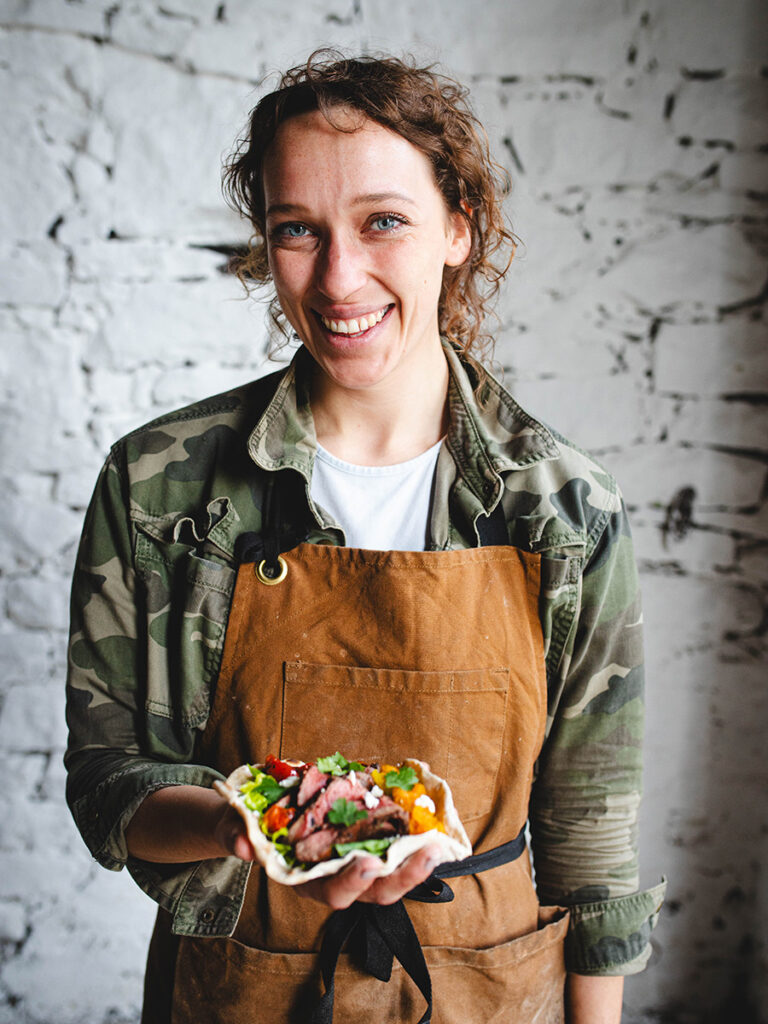
Flaming Venison Flatbreads
Makes 12, feeds 6. Depending on how hungry you are.
Ingredients
Venison
- 1 roe haunch, seam butchered
The top rump butterflied is great for cooking on the fire. Also works well with strip loin. Once marinated, pull the venison out of the fridge at least one hour before cooking.
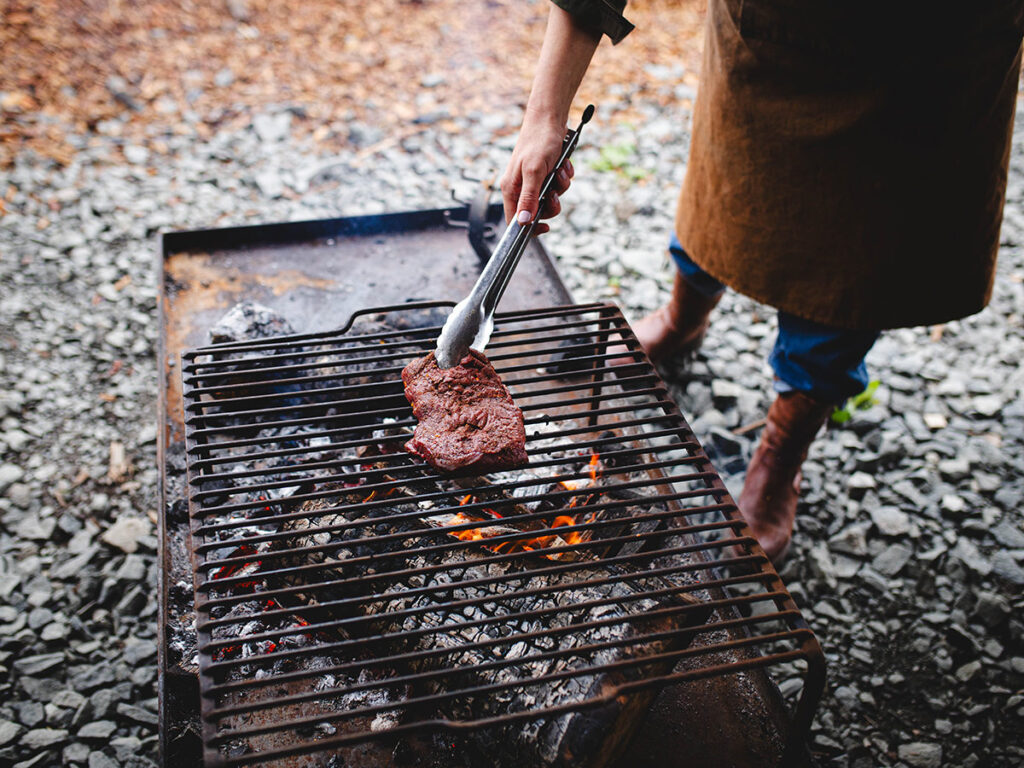
BBQ Rub
- 1 teaspoon sea salt
- 1 teaspoon mixed chili flakes (such as chipotle and ancho chili flakes)
- ½ teaspoon garlic granules
- 1 teaspoon paprika
- 1 tablespoon brown sugar
- 1 tablespoon ground coffee
Mix all of the ingredients above together and rub over the venison. Make sure you get in all of the nooks and crannies. Ideally, marinade it overnight, or for a minimum of 2 hours in the fridge.
Flatbreads
- 2 cup Greek yogurt
- 3 cups self-raising flour, plus a handful for dusting
- Dash of olive oil
- Pinch of salt
In a bowl, add 1 cup of flour to the yogurt, a pinch of salt, and the dash of olive oil. Give it a stir. Gradually add in more flour until the dough starts to form into a ball.
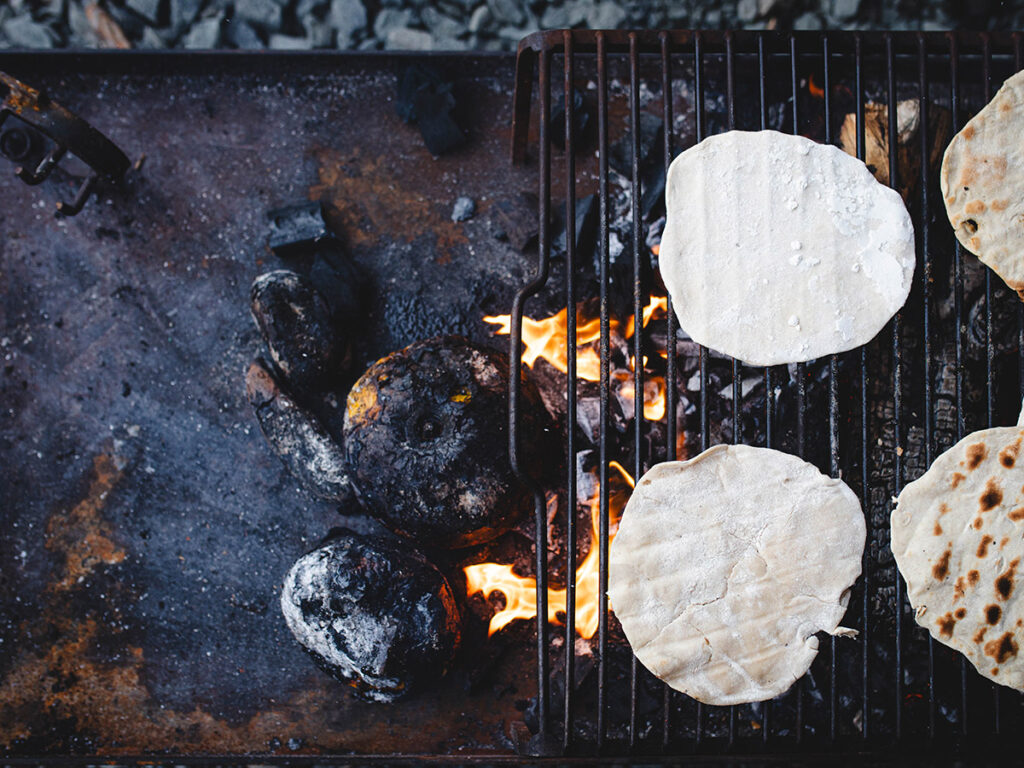
Tip the dough ball onto a well-floured surface and knead for a few minutes. If it’s still sticky, add a little more flour. You know it’s ready when it holds its shape and doesn’t stick to your fingers. Divide into six equal parts and roll each ball into a round about the width of your outspread hand.
Other Ingredients
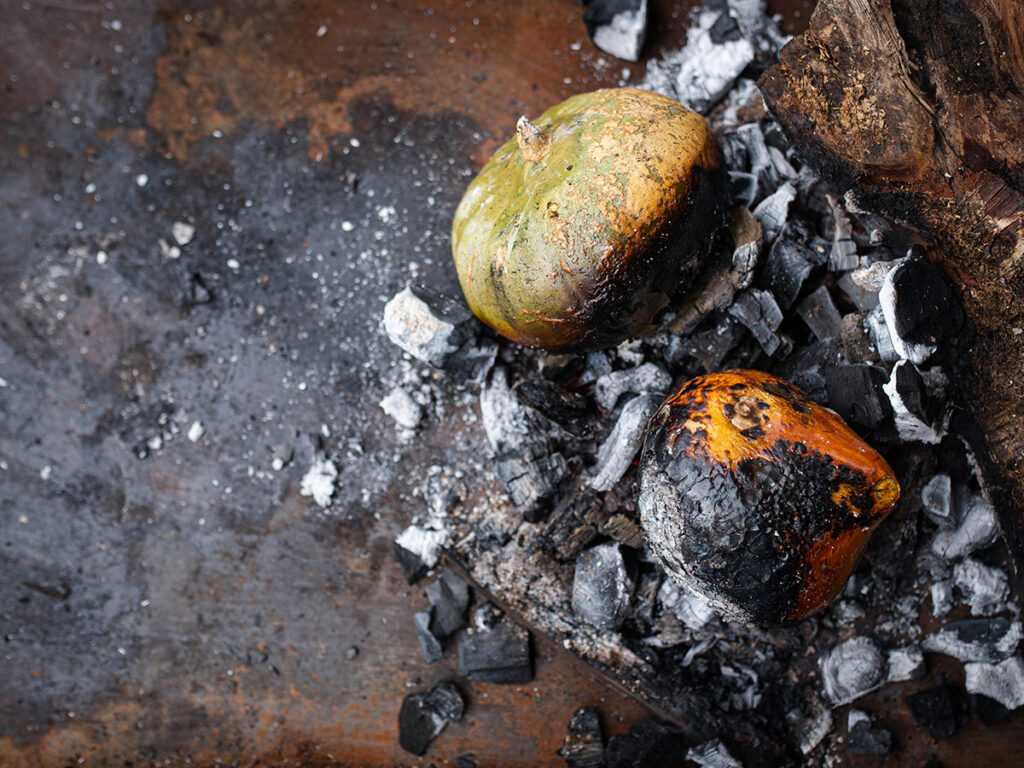
- 2 butternut squash (or late summer squash)
- 1 pound cherry tomatoes
- Salad leaves
- Greek yogurt
- Crumbled feta
- Chopped coriander
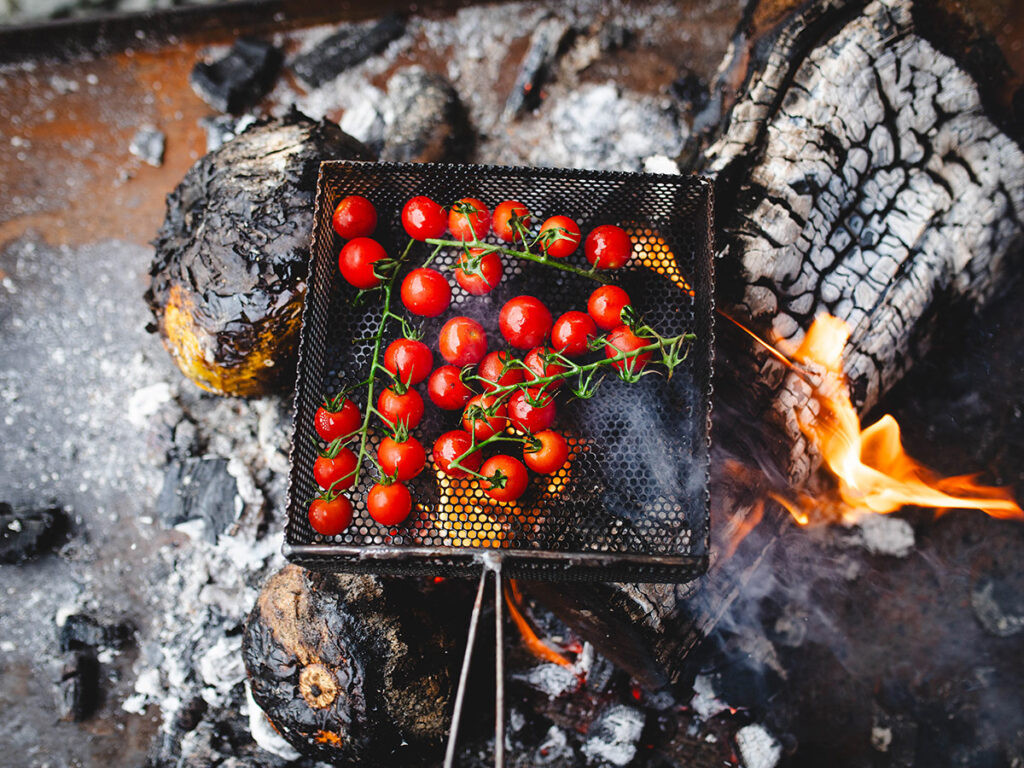
Method
- Light your fire (I prefer to use a mixture of local lump wood charcoal and seasoned wood). Let your fire get roaring hot, preferably white and flaky gray. It’s a good idea to light a “mother” fire next to your cooking fire, especially in more adverse weather conditions, so you can keep adding fuel and transferring smoking hot coals over to your cooking fire. Pour yourself a whisky.
- Add the squash (whole, just as they are) to the edge of the coals. Occasionally, turn them and push them in the coals for about an hour or so. The skin will burn and then go white and flaky, just like the coals. Leave them to do their thing in the fire. They’re ready when they become soft and squidgy when you give them a squeeze. They’ll look burnt to hell — but that’s when the good stuff happens to the natural sugars inside.
- While the squash are cooking, have a taste of that whisky, then set a grill over your fire and let it get hot for 5 to 10 minutes. Pop your tomatoes in a grill basket or a heatproof or cast-iron griddle pan with a drizzle of oil and put it on the grill. These will get a bit of color and start to blister (should take about 10 minutes). You can put the grill basket straight on the flames if you prefer, and they’ll blister quicker. Set aside once cooked.
- Check the fire; make sure it still has plenty of hot glowing wood and coals. If not, transfer some over from the mother fire. Lay the venison on the grill and let it cook until it has a good sear on it. This should take roughly 4 minutes; however, fire cooking is mostly by sight and feel. It totally depends on the thickness of venison, the weather, and how hot your fire is, to name just a few factors. Turn the venison over and do the same on the other side. Use a meat thermometer to be sure — you’re looking for 125 degrees F for a medium rare. Make sure to check both the thicker and thinner parts, and once it’s at 125 degrees F, take the venison off the fire, cover it, and let it rest for at least 5 to 10 minutes. While resting and relaxing, it should come up to around 130 degrees F in temperature. Take a deep breath and revel in how delicious this smells. Then, do some resting and relaxing yourself. Go on, have another wee taste of that whisky.
Once the butternut squash are done, take them out of the coals and chop off the top stalk and the bulb end (with the seeds) and discard them. Chop the rest of the squash up, including the black charred skin.
While the venison is resting, make sure you still have a good amount of heat under the grill on the fire. Drizzle the flatbreads with olive oil and lay them on the grill. They should take around 30 seconds to a minute on each side until they’re cooked through and have brown spots all over them.
Once the venison hits 130 degrees F for medium rare, slice it up.
You’re now ready to assemble: flatbread first, smoosh of Greek yogurt, a few salad leaves of choice, charred squash, blistered tomatoes, slices of venison, sprinkle of crumbled feta, and a few coriander leaves on top. Voila! This is best enjoyed with … you guessed it, whisky.
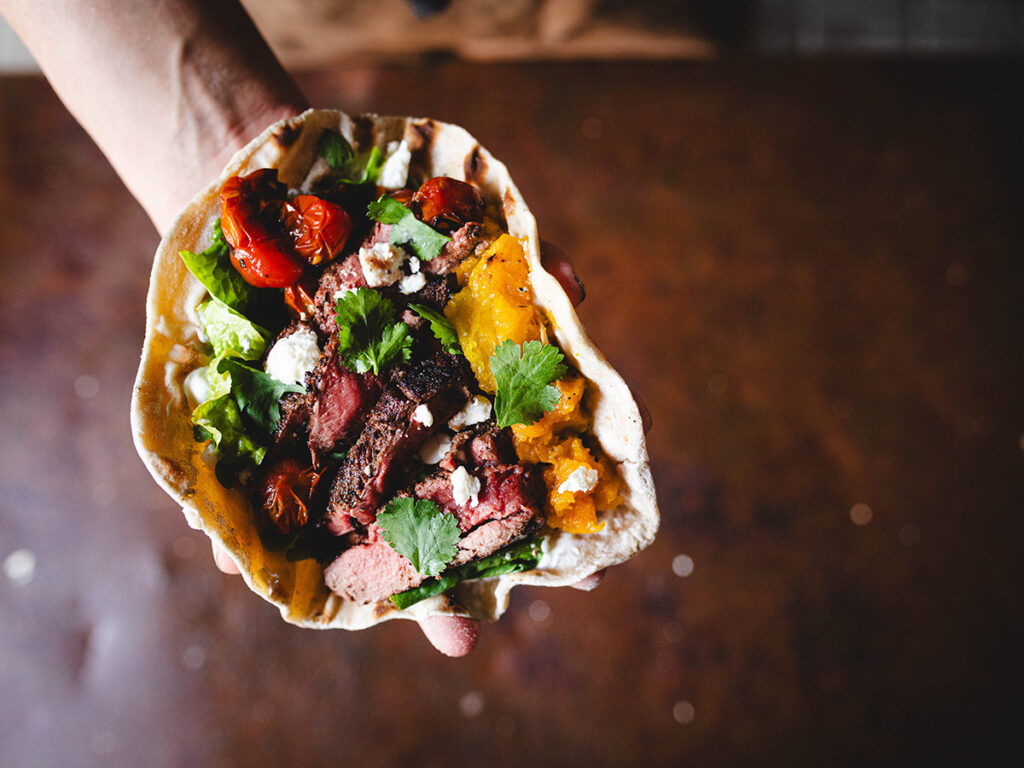
If you’re feeling extra fancy, you can make what we call a “Lucy Special:”
Wild Green Sauce
Why is it wild? Because it’s always changing depending on the seasons and my state of mind. You can use almost anything you fancy in this — herbs, nettles, green vegetables … Just have a go!
Put all of the below ingredients except the olive oil in a blender. Blitz to desired consistency; I like to keep it a bit chunky for this recipe. Once all combined, slowly add the oil to help it emulsify.
- Whatever you’d like; used here are a handful of spinach, some fennel tops, couple of ramps, and a handful of parsley.
- 100ml good quality olive oil (to add at the end)
- 1 tablespoon sherry vinegar
- 1 teaspoon dijon mustard
- 1 teaspoon honey
- 2 garlic cloves
- Squeeze of lemon juice
- Salt and pepper to taste
Editor’s Note: This article originally appeared in Carnivore Magazine Issue 9.
Why You Can Trust CARNIVORE
Since its launch, CarnivoreWeb.com has been a trusted authority on hunting, fishing and wild food, delivering expert insight for outdoorsmen who live the field-to-table lifestyle. More than a hunting and fishing site, CarnivoreWeb.com covers the full spectrum of the modern outdoors—from rifles, bows, and fishing gear to cooking, conservation and adventure.
Our contributors are drawn from across the hunting and angling world, including seasoned guides, lifelong hunters, competitive shooters and outdoor writers with decades of field experience. Every review, article and feature is built on firsthand testing, deep research, and an unwavering commitment to accuracy.
Commitment to Journalistic Principles
At CarnivoreWeb.com, upholding journalistic integrity is our top priority. We follow strict editorial standards to ensure all content is accurate, transparent, and unbiased. Our editors and writers operate independently, free from outside influence, advertisers or stakeholders. We adhere to established journalistic codes of ethics, holding ourselves accountable for the information we publish, correcting errors when they occur and disclosing any potential conflicts of interest.
This commitment ensures that our readers can trust CarnivoreWeb.com to provide reliable, honest coverage that helps them make informed decisions—whether selecting gear, honing outdoor skills or preparing wild game.
Find out more about our Editorial Standards and Evaluation Process


